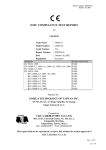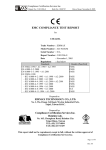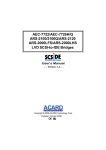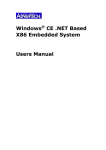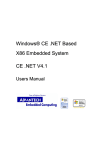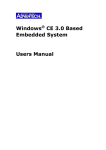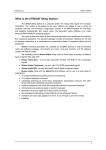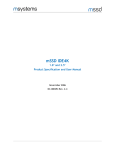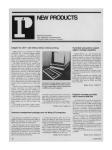Download EPOX Motherboard An Intel Socket 478 Processor Based Mainboard (400/533MHz)
Transcript
C3 Introduction In September 2003, there is a new curriculum implemented in schools commencing. It will replace the original curriculum for computer studies and curriculum for information technology. There are four electives included in new curriculum. One of the electives is Organisation of Computer. In this report, I will focus on the basic concepts of operating a personal computer, the possibility of upgrading personal computers and the main components of a personal computer. Also, a report of the performance of different personal computers assembled by different computer parts such as display card, CPU, RAM, etc. will be shown. All in all, the organization of a personal computer is a must for the students to understand. 1 C3 Table of Contents Introduction-------------------------------------------------------------------------------------P.1 Table of Contents------------------------------------------------------------------------------ P.2 A. Objective ¾ The description of issues-----------------------------------------------------------P.3 ¾ The requirement of the task--------------------------------------------------------P.3 ¾ Difficulties of producing the report-----------------------------------------------P.3 B. Problem analysis ¾ The solution of the difficulties-----------------------------------------------------P.4 ¾ The software are used---------------------------------------------------------------P.4 C. Solution design ¾ Blueprint of the solution design---------------------------------------------------P.5 D. Implementation ¾ Overview of Personal Computers 1. Evolution of personal computers-------------------------------------------P.6 2. Family of personal computers----------------------------------------------P.7 ¾ Processors comparison 1.Basic concepts of CPU operation--------------------------------------------P.8 2.Test-------------------------------------------------------------------------------P.9 3.Benchmark Results-----------------------------------------------------------P.10 ¾ RAM comparison 1. Basic concepts of RAM operation---------------------------------------P.11 2. Test---------------------------------------------------------------------------P.12 3. Benchmark results----------------------------------------------------------P.13 ¾ Overview of Mainboards, Buses, I/O Interfaces and peripheral handling-------------------------------------------------------------------------P.14-19 E. Conclusion---------------------------------------------------------------------------------P.20 2 C3 A. Objective The description of issues Nowadays, the prevalent of information technology accelerate the development of personal computers. Since the software that we are using such as CAD, PC Games and Operation systems need the personal computers have powerful performance, otherwise, some software cannot be run. Therefore, it is necessary for us to upgrade the hardware inside personal computers to attain the system requirement of the new software. The requirement of the task To raise the performance of the computers, there are some personal computers components are needed to upgrade. Central Process Unit (CPU), Random Access Memory (RAM) Graphic card and Mainboard are the heart of a personal computer and these components are the key to determine the performance of a personal computer. Hence, the main upgrade parts are these components. Difficulties of producing the report Firstly, the most difficult problem is that it is hard to get many different of personal computers components for the test or comparison. Secondly, the compatibility of different hardware is not guaranteed. There is the chance to interrupt between the personal computers parts such as SDRAMS are not supported by the new mainboard. So it will add the difficulty on the comparison between the different personal computers. Thirdly, the equipment of different personal computers may not be same. It is difficult to identify the performance of the only one hardware. 3 C3 B. Problem analysis The solutions of difficulties Difficulties of producing the project Solutions 1. The problem of getting the hardware to test 1. Refer to the website of hardware 2. Compatibility of different is not guaranteed 2. Try to read the manual or the FAQ section to solve the interruption problem 3. The difficulty of getting the same 3. Try to get the familiar equipment to equipment of personal computers to test the make the test fairly. specific hardware The software are used In this report, some software is used for the test of hardware. For testing the performance between different hardware, 3Dmark 2001 SE, Quake 3 arena demo and SiSoft Sandra 2002 Benchmarks are used. 4 C3 C. Solution design Blueprint of the solution design In this report, first, there is an overview of personal computers. Secondly, there are the basic concepts operations of CPUs, RAMs and mainboards. Thirdly, the comparisons of different families of CPUs, RAMs and Graphic cards had been made. Through the comparison, we can identify that which hardware is most suitable for the one specific purpose. Fourthly, there are the overviews of mainboards, buses, I/O interfaces and peripheral handling. In the overviews, it can let the students know the operation of a personal computer. 5 C3 D. Implementation Overview of Personal Computer 1. Evolution of personal computers About 1300 The more familiar wire-and-bead abacus replaces the Chinese calculating rods. It is the first calculator. 1935 IBM introduces not only the 601 multiplying punch-card machine but also an electric typewriter. 1943 In December, Colossus, a British vacuum tube computer, becomes operational at Bletchley Park trough the combined efforts of Alan Turing, Tommy Flowers, and M.H.A Newman. It is considered the first all-electronic calculating device. 1945 J.Presper Eckert and John Mauchly sign a contract to build the EDVAC (Electronic Discrete Variable Automatic Computer). 1975 The first PC, an Altair 8800, available as a kit, appears on the cover Popular Electronics in January. 1976 Steve Jobs and Steve Wozniak design and build the Apple I, which consists mostly of a circuit board. 1980 IBM selects PC-DOS from upstart Microsoft as the operating system for its new PC. 1983 The IBM PC-XT heads for market success, while the PC Junior faces quick extinction. 1985 With the development of Windows 1.0, Microsoft brings Macintosh-like features to DOS-compatible computers. 1993 Intel's Pentium is introduced in March. 1995 Windows 95 is launched on August 24 with great fanfare. 6 C3 2. Family of personal computers In the present market, there are two main streams of computers: IBM PC and Apple Macintosh. IBM PC In July of 1980, IBM representatives met for the first time with Microsoft's Bill Gates to talk about writing an operation system for IBM's new hush-hush "personal" computer. IBM had been observing the growing personal computer market for some time. They had already made one dismal attempt to crack the market with their IBM 5100. At one point, IBM considered buying the fledgling game company Atari to commandeer Atari's early line of personal computers. However, IBM decided to stick with making their own personal computer line and developed a brand new operating system to go with. The secret plans were referred to as "Project Chess". The code name for the new computer was "Acorn". Twelve engineers, led by William C. Lowe, assembled in Boca Raton, Florida, to design and build the "Acorn". On August 12, 1981, IBM released their new computer, re-named the IBM PC. The "PC" stood for "personal computer" making IBM responsible for popularizing the term "PC". The first IBM PC ran on a 4.77 MHz Intel 8088 microprocessor. The PC came equipped with 16 kilobytes of memory, expandable to 256k. The PC came with one or two 160k floppy disk drives and an optional color monitor. The price tag started at $1,565, which would be nearly $4,000 today. What really made the IBM PC different from previous IBM computers was that it was the first one built from off the shelf parts (called open architecture) and marketed by outside distributors (Sears & Roebucks and Computerland). The Intel chip was chosen because IBM had already obtained the rights to manufacture the Intel chips. IBM had used the Intel 8086 for use in its Displaywriter Intelligent Typewriter in exchange for giving Intel the rights to IBM's bubble memory technology. Apple Macintosh In December, 1983, Apple Computers ran its' famous "1984" Macintosh television commercial, on a small unknown station solely to make the commercial eligible for awards during 1984. The commercial cost 1.5 million and only ran once in 1983, but news and talk shows everywhere replayed it, making TV history. The next month, Apple Computer ran the same ad during the NFL Super Bowl, and millions of viewers saw their first glimpse of the Macintosh computer. Ridley Scott directed the commercial, and the Orwellian scene depicted the IBM world being destroyed by a new machine, the "Macintosh". 7 C3 Processors comparison 1. Basic concepts of CPU operation A CPU normally consists of the following parts: Control Unit This fetches instructions from main memory and determines their type. Arithmetic Logic Unit This performs all the necessary arithmetic functions, such as add and subtract; logical functions, like AND and OR; and shifting operations. Registers The CPU's registers are used to store temporary results and control information. Program Counter The Program Counter contains the address of the next instruction to be executed. Instruction Register This holds the instruction currently being executed. Cache This is a small amount of high-speed memory, which is used to store data the CPU is currently working on. Translation Lookaside Buffer This enables the CPU to obtain the physical address of a piece of data quickly. Each entry in the TLB maps a logical page of memory onto a physical page of memory. The TLB is associative: that is the CPU can compare the entry it is trying to match with all the TLB entries at once. If a match is found the logical block number can be replaced by the physical block number, giving the desired physical address. In a von Neumann machine (one in which only one thing is done at a time; there is one bus for both code and data; and the program is stored in memory) the CPU continually executes a Fetch-Decode-Execute cycle. This can be broken down into the following parts: 1. Fetch the next instruction from memory into the Instruction Register. 2. Increment the Program Counter to point to the following instruction. 3. Determine the type of the instruction. 4. If the instruction uses data from memory find the data (search Cache, TLB and Secondary Memory) and load it into CPU's internal registers. 5. Execute the instruction. 6. Place results in appropriate registers. 8 C3 2. Test The latest model of Intel CPU is Pentium 4 series. The latest model of AMD CPU is Athlon series. To test which CPU is most value to purchase. There is the test of Intel Pentium 4 2800Mhz and AMD Athlon XP 2600+. Test setup and details Intel Hardware & Software (Socket 478) Processors Pentium 4 2.8 GHz (2800 MHz) 133 MHz FSB 533 MHz Memory Clock Motherboard and Memory Asus P4T533-C (Intel 850E Chipset) Revision: 1.01 Bios: 1006 BETA 002 (07.08.2002) 2x 256 MB RDRAM, PC800, 533 MHz, 40ns, Infinion 2x 256 MB RDRAM, PC1066, 533 MHz, 32ns, Kingstone Driver Intel 850E Driver V 4.00.1013 (7.06.2002) Intel IAA Driver V 2.2.0.2126 AMD Hardware (Socket 462) Processors Athlon XP 2600+ (2133 MHz) 133 MHz FSB 166 MHz Memory Clock Motherboard and Memory Epox EP-8K3A+ (VIA Apollo KT333 Chipset) Revision: 1.0 Bios: 8k3a2328 (19.06.2002) 512 MB DDR-SDRAM, CL2.0, 166 MHz, PC2700, Winbond Drivers VIA KT333 Driver 4 in 1 Version: 4.40(a)P3 INF File Version: 1.60a AGP Driver Version: 4.20a IDE Filter driver Version: 1.20 Common Hardware 9 C3 Graphics Card GeForce 4 Ti 4600 (MSI MS-8872) Version: 2.00 Memory: 128 MB DDR-SDRAM Memory Clock: 650 MHz Chip Clock: 300 MHz Hard Drive 40 GB,6L040J2 , Maxtor UDMA100, 7200 U/min, 2 MB Cache Network D-Link DFE-530TX (10/100 Mbit) CDROM Asus 52x Drivers and Software Graphics Driver Detonator 4 Serie Version: 29.42 DirectX Version: 8.1 OS Windows XP, Build 2600 Benchmarks and Settings 3DMark 2001 SE Version 1.1 Build 340 Patch Build 330 1024 x 786 - 32 bit Default Benchmark SiSoftware Sandra Standard 2002 Version 2002.6.8.97 SP1 CPU Benchmark 3. Benchmark Results 3D Mark 2001 SE: Pentium 4 2.8 GHz (2800/133/533MHz): 12885 Athlon XP 2600+ (2133/133/166): 11831 SiSoft-Sandra 2002 SP1 CPU Bench: Pentium 4 2.8 GHz (2800/133/533MHZ): 3488/5926 Athlon XP 2600+ (2133/133/166): 2928/6071 From the figure, we can see that although Pentium 4 gets a higher MHz than Athlon XP, in fact, the performance of Pentium4 and Athlon XP is nearly the same. On the other hand, the price of Athlon XP is cheaper than Pentium 4. Therefore, Athlon XP has the best price/ performance ratio than Pentium 4. RAM comparison: 10 C3 1. Basic concepts of RAM operation A DRAM memory array can be thought of as a table of cells. These cells are comprised of capacitors, and contain one or more ‘bits’ of data, depending upon the chip configuration. This table is addressed via row and column decoders, which in turn receive their signals from the RAS and CAS clock generators. In order to minimize the package size, the row and column addresses are multiplexed into row and column address buffers. For example, if there are 11 address lines, there will be 11 row and 11 column address buffers. Access transistors called ‘sense amps’ are connected to the each column and provide the read and restore operations of the chip. Since the cells are capacitors that discharge for each read operation, the sense amp must restore the data before the end of the access cycle. The capacitors used for data cells tend to bleed off their charge, and therefore require a periodic refresh cycle or data will be lost. A refresh controller determines the time between refresh cycles, and a refresh counter ensures that the entire array (all rows) are refreshed. Of course, this means that some cycles are used for refresh operations, and has some impact on performance. A typical memory access would occur as follows. First, the row address bits are placed onto the address pins. After a period of time the RAS\ signal falls, which activates the sense amps and causes the row address to be latched into the row address buffer. When the RAS\ signal stabilizes, the selected row is transferred onto the sense amps. Next, the column address bits are set up, and then latched into the column address buffer when CAS\ falls, at which time the output buffer is also turned on. When CAS\ stabilizes, the selected sense amp feeds its data onto the output buffer. Virtual Memory: A technique your operating system uses to make up for a lack of actual physical memory. When your computer needs more memory than it actually has installed, it uses the hard drive as virtual memory. Just as data is saved and read from memory, but at a much higher speed, the system does this on the hard drive. Due to the mechanical nature of the hard drive, it is slower. This explains why your hard drive may be quite active while it appears you are doing nothing. It also explains a lot of drawbacks on performance. 11 C3 2. Test Many users often overestimate the role that the processor plays in determining the performance of a PC system. In practice, slow RAM modules in combination with the chipset are what hampers optimal performance - the result is that the CPU cannot run on a full load. Test setup and details Intel Hardware Socket 478 Processor Intel Pentium 4/2400 MHz (100/133 MHz FSB) Memory Memory 1 (RDRAM) 2 x 128 MB, RDRAM, 400 MHz, Samsung, 40 ns Memory 2 (RDRAM) 2 x 128 MB, RDRAM, 533 MHz, Samsung, 35 ns Memory 3 (DDR266) 256 MB, DDR-SDRAM, 133 MHz, CL2.5 Memory 4 (DDR266) 256 MB, DDR-SDRAM, 133 MHz, CL2 Memory 5 (DDR333) 256 MB, DDR-SDRAM, 166 MHz, CL2.5 Memory 6 (DDR333) 256 MB, DDR-SDRAM, 166 MHz, CL2 Memory 7 (DDR200) 2 x 128 MB, DDR-SDRAM, 100 MHz, CL2 Memory 8 (DDR400) 256 MB, DDR-SDRAM, 200 MHz, CL2.5 Memory 9 (RDRAM) 2 x 128 MB, RDRAM, 600 MHz, Samsung, 32 ns General Hardware Graphics Card GeForce 3 Ti 500 Memory: 64 MB DDR-SDRAM, Memory clock: 250 MHz DDR Chip clock: 240 MHz Hard Disk 40 GB, 5T040H4, Maxtor, UDMA100 7200 rpm 2 MB Cache Drivers & Software Chipset Driver (Intel) 4.08. 12 C3 AGP Driver (SIS) V1.09 Graphics Driver Detonator 4 Serie 28.32 DirectX Version 8.1 Operating System Windows 2000, Service Pack 2 Benchmarks & Settings SiSoft Sandra 2002 Professional Version PC Mark 2002 Benchmark results DDR-SDRAM VS RDRAM Quake 3 Arena ‘Demo001’ Pentium 4/2400, Win2000 Pro. SP2 RDRAM PC1200, 600MHz, Intel 850: 414.3 fps RDRAM PC1600, 533MHz, Intel 850: 381.6 fps DDR333 CL2, 166MHz, future chipset 1: 365.3 fps DDR266 CL2, 133MHz, future chipset 1: 336.3 fps RDRAM PC800, 400MHz, Intel 850: 335.2 fps DDR400 CL2.5, 200MHz, SiS 645DX: 322.6 fps DDR266 CL2, 133MHz, future chipset 2: 320.2 fps DDR333 CL2, 166MHz, SiS 645DX: 313.4 fps DDR266 CL2, 133MHz, SiS 645DX: 294.6 fps DDR200 CL2, 100MHz, future chipset 1: 284.0 fps DDR CL2, 100MHz, future chipset 2: 283.4 fps From the digit, we can realize that RDRAM used in the Intel chipset mainboard is faster than use DDR-SDRAM in SiS chipset mainboard. All in all, the performance is much depends on the mainboard chipset. Overview of mainboard, Buses, I/O 13 C3 Interfaces and peripheral handling When selecting a motherboard, considerations include processor and processor package support, system bus speed (Front Side BUS or FSB), chipset features such as memory and graphics support, disk drive interface (ATA/100), RAID support, USB ports (number of ports, speed and location), I/O bandwidth, audio and networking options, general board layout and form factor (which relates to the number of PCI slots). So basically the mainboard defines the whole system and the components it can exist off. Besides the visible components of the mainboard there are also the invisible but highly important system resources. The system resources can cause severe stability problems or can cause devices to fail to function if they are not assigned properly. Basic components: • Chipset (see below) • BIOS chip (see below) • CPU Interface - In slot or socket format. There are different kinds of slots and sockets for different kinds of processors. • Memory sockets - for plugging in memory modules. There are different kinds of sockets for different kinds of memory. • PS/2 keyboard connector (1x) - For connecting a PS/2 keyboard. • PS/2 mouse connectors (1x) - For connecting a PS/2 mouse. • Serial (COM) port connectors (2x) - Usually for connecting modems or mice but there are also other hardware devices that can be connected to it or it can be used to connect to another computer directly with a serial port link cable. • Parallel port connector (1x) - Usually for connecting printers but there are also other hardware devices that can be connected to it or it can be used to connect to another computer directly with a parallel port link cable. BIOS setting for this port should be EPP, ECP or EPP+ECP for most parallel port devices since SPP is usually too old for the devices to function with. • Floppy Disk Drive connector (1x) - The one thing that ALL mainboards have universally in common and of which the functionality has not changed in years is the Floppy Disk Drive (FDD) connector for connecting the almost always present standard 3.5" floppy drive. • IDE connector (2x) - For connecting up to 4x IDE devices like for example Hard Disk Drives, CD and DVD devices. 14 C3 • AGP Slot (1x) - For adding an AGP graphics card. There are 2x AGP slots, 4x AGP slots and Universal AGP slots. • PCI Slots - For adding PCI cards for graphics, sound, network, modem, RAID, SCSI or other expansion cards. • ISA Slot(s) - For adding legacy ISA cards usually for sound, network or modem, These slots are less and less often present on mainboards because only PCI versions of those cards are available for sales. If you do not have a legacy ISA card that you still wish to use you can forget kind of slot. • USB ports (2x minimum, 4x or 6x with extra USB adapter cable) - These ports are for connecting a myriad of USB devices. Because most modems, mice, printers and scanners can now connect to the fast USB ports the Serial and Parallel ports are usually becoming less used and those unused ports can then be disabled in the BIOS. • IrDA header (1x) - Most of our mainboard have an IrDA-header on the mainboard where you can attach an IrDa adapter like the ACTiSYS IR210L for example. With some mainboards you have to use the BIOS settings: "Serial Port 2 Mode"="IrDA" "RX,TX active"="Hi, Hi" "Delay"="Enabled". There is an IrDA header on most of our mainboards for connecting an IrDA connector from the mainboard to the casing. Our QDI Infrared port supports two IrDA standards, one is Intel spec (5-pin), another is SMC spec (4-pin), as illustrated in the following table: QDI IrDA Connector (IR HEADER) Standard Pin Number Intel Spec. SMC Spec. 1 VCC -- 2 NC -- 3 IRRX IRRX 4 GND GND 5 IRTX IRTX 6 -- VCC Optional components: • Video output connector (1x) - For on-board video. • Audio plug connectors (3x) plus Midi (joystick) port connector (1x) - For on-board audio. 15 C3 • Network Interface (1x) - An RJ45 connector for on-board network. • AMR (Audio Modem Riser) Slot (1x) - Intel and VIA chipset for AMR modem and audio cards. • CNR (Communications and Networking Riser) Slot (1x) - Intel and SiS chipset, replaced AMR to include network card solution • ACR (Advanced Communications Riser) slot (1x) - VIA chipset, replaced AMR to include network card solution • SCR (Smart Card Reader) connector (1x) • SCSI (Small Computer System Interface) connectors - Various connectors for connecting Narrow, Wide or Ultra-Wide SCSI devices. Only present on some older mainboards designed for Server systems. Chipset The chipset is the most important component of the mainboard. Or actually components because a chipset usually consists of two chips, generally the two biggest chips present on the mainboard. All components communicate with the processor through the chipset - it is the hub of all data transfer. Each chipset consists of a Graphics and/or Memory Controller Hub, which interfaces directly with the processor, and the I/O Controller Hub. The I/O Controller Hub provides the PCI, disk drive, network, USB, audio and other I/O interfaces to peripherals. Thus, the chipset determines most of the add-on components that will work with the system, and how efficiently they can transfer data. Because chipsets have to be able to communicate with all PC components, choose one designed to optimize your processor and configuration. The main chipsets used on our mainboards are from: • Intel - Only for Intel processor based mainboards. • Via - For Intel, AMD and VIA processor based mainboards. Comes in two general types with Apollo chipsets and ProSavage Chipsets. • SiS: For Intel, AMD and VIA processor based mainboards. BIOS The Basic Input Output System (BIOS) is the only part of the mainboard that can be changed and updated in is located in a chip with an AWARD or PHOENIX label. Practically always an AWARD BIOS is used and sometimes a Phoenix BIOS but they are both from the company Phoenix Technologies and you can find a whole lot of detailed information about the BIOS functionality and features on their website under Support - White papers & Specs.. The use of the proper BIOS update is vital 16 C3 because the BIOS is specifically made for specific mainboard models to support their chipset and features and it tells the mainboard how to start working. More information about BIOS updates can be found in the BIOS information page. System resources • • • • • When you install a Plug and Play device the BIOS automatically configures the device so it will work properly with the other devices that are installed on your computer. However after the initial booting the operating system can take that over from the BIOS and use the configuration that is determined in the operating system settings. As part of that configuration process a unique set of system resources are assigned to the devices installed. These resources can include one or more of the following: Interrupt request (IRQ) line numbers. - Decimal values: 0 to 15. Hardware lines over which devices can send signals to get the attention of the processor when the device is ready to accept or send information. Each device must have a unique IRQ line but it is possible that there are more devices than the limited amount of 16 IRQ's. See below. Direct memory access (DMA) channels. - Decimal values: 0 to 8. These are used for direct data transfer between a device and the system memory without involving the processor. Input/output (I/O) port addresses. - Hexadecimal values: 0000 to FFFF (0 to 65535 in decimal values). These are ports in the shape of memory addresses for the two-way communication of data between the processor and the device that the involved memory address is assigned to. Devices are assigned single addresses or a range of addresses. Memory address ranges. - A portion of the main system memory that can be assigned to a device, a program or the operating system. This is the only resource in this list of which the amount of values is not fixed but dependant on the amount of memory installed with memory modules. Each resource that is assigned to your device must be unique or the device will not function properly. Due to the BIOS or operating systems automatic detection and assignment of those resources two devices may end up with the same resources, resulting in a device conflict that can cause the system to run unstable or to fail booting. If this occurs, you can usually manually change the resource settings in most operating systems device management to be sure each setting is unique. 17 C3 However this can be a problem with the IRQ's because due to the legacy of the past each and every mainboard of every manufacturer has only 16 IRQ's available but the amount of possible devices that a system can have has increased beyond that. Generally the following IRQ's are practically standard for mainboards: IRQ 00 = System timer IRQ 01 = Keyboard IRQ 02 = I/O controller IRQ 06 = Floppy Disk Controller IRQ 08 = System Clock IRQ 12 = PS/2 mouse IRQ 13 = Numeric Data processor IRQ 14 = IDE 1 IRQ 15 = IDE 2 That usually only leaves the IRQ's: 03, 04, 05, 07, 09, 10, 11. Usually those are used for: IRQ 03 = COM 1 IRQ 04 = COM 2 IRQ 05 = Soundcard IRQ 07 = LPT/printer port IRQ 09 = ACPI bus IRQ 10 or 11 = Graphic card That would leave only IRQ 10 or 11 for all the other devices you may wish to use like for example USB, network card, SCSI, etc.... To solve that problem most recent operating systems started using "IRQ-sharing" to handle that shortage but that depends strongly on the component drivers and hardware design. Unfortunately in practice when the sharing involves most graphic cards, sound cards, network cards or USB controllers that usually causes a stability problem or devices do not function at all. So to solve the "IRQ sharing" problem that only leaves freeing up IRQ's by disabling unused components like for examples the COM-ports, parallel/printer port in the BIOS if there is nothing attached to them. Some graphics cards do not necessarily need an IRQ and therefore it is also possible to disable the assigning of the IRQ to the VGA cards. However some cards just need an IRQ or they are unstable or do not even work at all. You would have to try that out to discover what works or does not work with your card when it comes to the IRQ. 18 C3 19 C3 E. Conclusion If we need to assemble or buy a personal computer in order to enhance the personal computer performance, we need to notice what are you want to do with the computer. If you just use the computer for typing or surfing website, a computer with Celeron or Duron is enough for the work. If you use the computer for gaming or graphic design, u may need a computer with Pentium 4 or Athlon XP and more of the RAM. Besides, the operation system is one of the factors that can affect the performance of a personal computer. If you want to have the maximium performance of the computer, we need to clear the redundant files in the hard disk and defrag the hard disk regularly. Generally speaking, we need to try a lot of attempts which can enhance the performance of a personal computer. 20




















